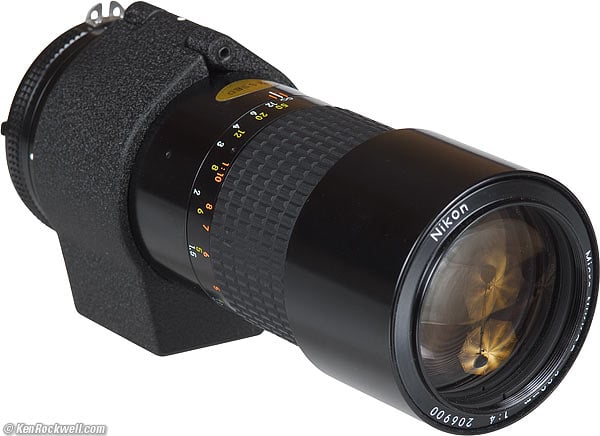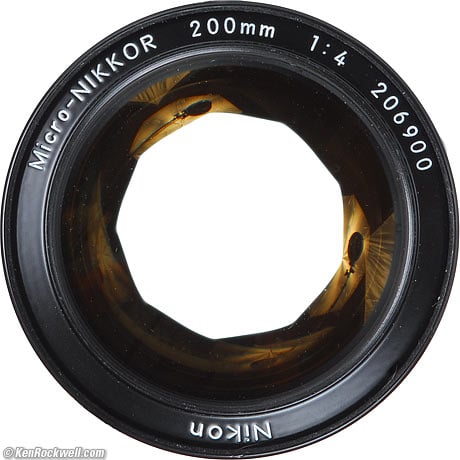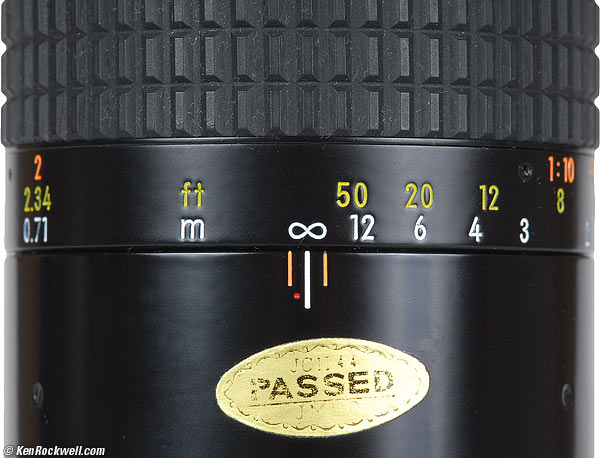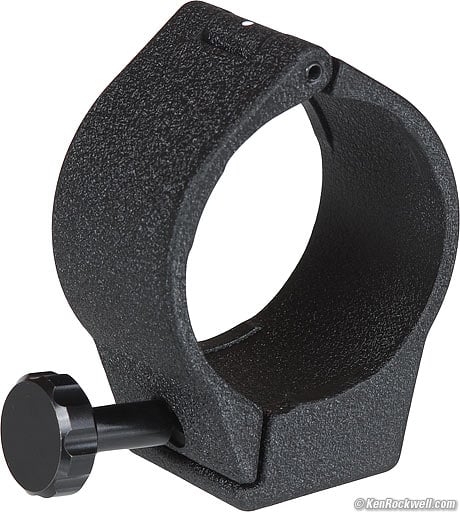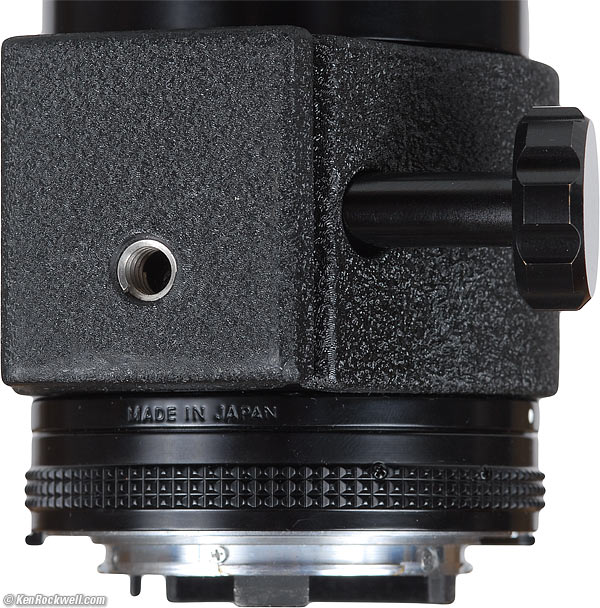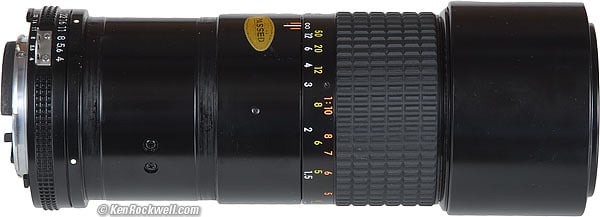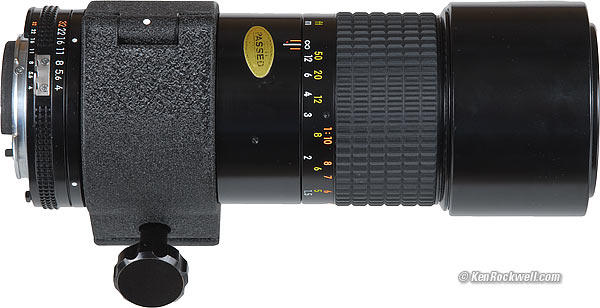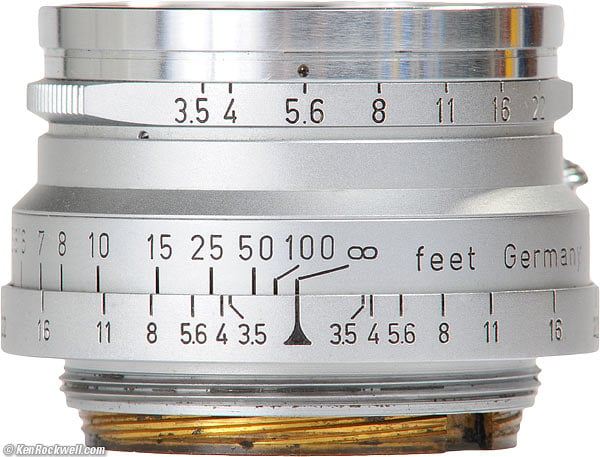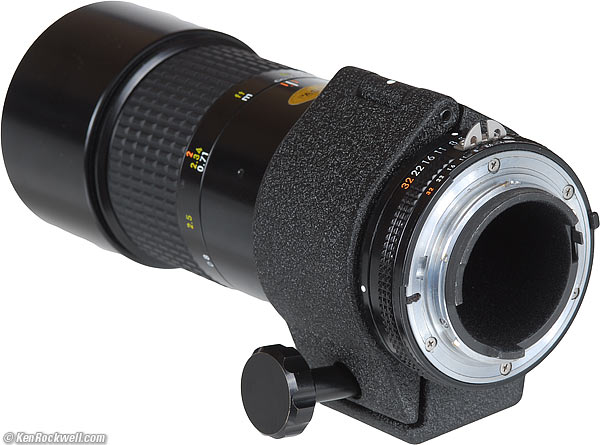Home Donate New Search Gallery Reviews How-To Books Links Workshops About Contact
Nikon 200mm f/4 AI-s
Micro-NIKKOR (1978-2005)
© 2013 KenRockwell.com. All rights reserved.
How to Shoot Macro Best Macro Lenses
Intro Specs Performance Usage Compared Recommendations
Nikon 200mm f/4 Micro-NIKKOR AI-s (metal 52mm filter thread, FX, DX and 35mm coverage, 29.1 oz./824g with collar but without caps, about $200 used). enlarge. I got this one from this direct link to it at eBay (see How to Win at eBay).
This all-content, junk-free website's biggest source of support is when you use those or any of these links to approved sources when you get anything, regardless of the country in which you live. Thanks for helping me help you! Ken.
April 2020 Better Pictures Nikon Reviews Nikon Lenses Nikon Flash All Reviews
Nikon 200mm Lens Center Sharpness Compared
Nikon 200mm Corner Sharpness Compared
Why fixed lenses take better pictures
Other Nikon 200mm f/4 lenses:
200mm Micro-NIKKOR AF-D (1993-today, AF)
200mm f/4 AI-s (1981-1996)
200mm f/4 AI (1977-1981)
200mm f/4 Q (1961-1976)
Ideal Uses
Perfect general-purpose close-focusing tele for film and FX, not much bigger or more expensive today than the regular 200mm f/4 AI-s.
Superb as a low-cost FX macro lens, too.
Not for
Not the best lens for macro product shots due to lateral color fringing at close distances. The current 200mm f/4 AF-D is far superior, and oddly, this AI-s lens has no problems at normal non-macro distances.
| Optics: | |
| Ergonomics: | |
| Usefulness: | |
| Availability: | |
| Overall: |
Introduction top
Intro Specs Performance Usage Compared Recommendations
|
Adorama pays top dollar for your used gear. I use these stores. I can't vouch for ads below. |
Compatibility History Production
The Nikon 200mm f/4 Micro-NIKKOR AI-s is precision incarnate. It is the world's first 200mm micro lens.
Everything about it says precise. The focus is out-of-this-world: one finger is enough to flick the focus ring, which feels as if it's floating on air, from infinity to 1:2.
This 200mm f/4 Micro-NIKKOR uses internal focusing, so nothing moves externally as focused.
It's a great lens for anything, however if you're shooting products with black-and-white graphics in the closest macro range and looking closely, you'll see some red-blue color fringing on sharp outlines at the sides.
Optics are excellent otherwise, and the mechanical quality of this piece is fantastic.
This manual-focus Nikon 200mm f/4 Micro-NIKKOR AI-s works great with most Nikon cameras, film and digital.
It works flawlessly with every manual focus Nikon ever made, from the F of 1959 through the FM3a and today's FM-10.
On the D3X, D3s, D3, D700, D300, D200, D2 and F6, use the "Non-CPU Lens Data" menu option to set 200mm and f/4 to get full color matrix metering, EXIF data and finder read-out of set aperture. It works great in aperture-preferred as well as manual modes on these cameras.
It works perfectly on every professional film camera (F, F2, F3, F4, F5, F6), and adds Matrix metering on the FA, F4 and F6.
The meters of cheaper digital (D90, D5000 and below) and cheaper film cameras (N80 and below) will not couple (or work at all) with this lens, so you'll be on your own guessing exposure using the rear LCD or an external meter, or get a tiny Gossen Digisix meter and adapter to meter manually.
See Nikon Lens Compatibility for details on your camera. Read down the "AI, AI-s" column for this lens.
1978-1982
This 200mm Micro-NIKKOR was available in its first AI version.
It has a thinner tripod collar and a wider aperture ring than the AI-s version shown here. It is identical optically.
1982-2005
The AI-s version shown here is a minor cosmetic update from the AI version, with the same optics.
The sample shown here is from the middle of 1990.
Nikon made about 40,000 of these 200mm f/4 Micro-NIKKOR lenses, 20,000 each of the AI and then the AI-s version.
Specifications top
Intro Specs Performance Usage Compared Recommendations
Name
Nikon calls this the Nikon Micro-NIKKOR 200mm f/4 AI-s IF.
IF means internal focusing; nothing moves externally as focused.
Optics top
Nikon 200mm f/4 Micro-NIKKOR AI-s. enlarge.
9 elements in 6 groups.
IF: Internal Focusing.
Multicoated, called Nikon Integrated Coating (NIC).
Diaphragm top
Nikon 200mm f/4 Micro-NIKKOR AI-s. enlarge.
9 straight blades.
Stops down to f/32.
Aperture Ring top
Yes.
Metal.
Full-stop clicks.
Close Focus top
2.34 feet.
0.71 meters.
Working Distance top
19.5" (500mm), hood retracted, at 1:2.
Maximum Reproduction Ratio top
1:2
Hard Infinity Focus Stop? top
Yes.
This is great for astronomy; just turn to the stop and you have fixed laboratory-perfect focus all night.
Focus Scale top
Yes.
Depth-of-Field Scale top
Nikon 200mm f/4 Micro-NIKKOR AI-s. enlarge.
Yes, but only two little ticks for f/32.
Infra-Red Focus Index top
Yes: red dot in depth-of-field scale.
Filter Thread top
52mm, metal.
Does not rotate or move, ever.
Tripod Collar top
Removable tripod collar:
Nikon 200mm f/4 Micro-NIKKOR AI-s Tripod Collar. enlarge.
Nikon 200mm f/4 Micro-NIKKOR AI-s Tripod Collar. enlarge.
Nikon 200mm f/4 Micro-NIKKOR AI-s without Tripod Collar. enlarge.
Size top
Nikon specifies 172mm extension from flange (180mm overall) by 66mm (AI-s) or 67mm (AI) diameter.
Weight top
AI-s version (1978-1982)
29.060 oz. (823.9g), with collar but without caps.
Lens alone: 22.382 oz. (634.6g).
Tripod Collar: 6.680 oz. (189.35g).
Nikon specifies 28.2 oz. (800g).
AI-s version (1982-2005)
Nikon specifies 26.1 oz. (740g).
Hood top
Built-in short telescoping hood.
Case top
CL-36.
Made in top
Japan.
Teleconverters top
TC-301 and TC-14B.
Nikon warns of potential vignetting with the TC-14A, and says to forget it with others.
Packaging top
Gold-foil box, foam innards.
Nikon Product Number top
1468.
Price top
This 200mm Macro was always a $1,000 lens when new.Used today, it's a screaming bargain.
Corrected for inflation, 2010 |
Price, new* |
|
1982 |
$885 |
$392 |
1983 |
$745 |
$339 |
1986 |
$735 |
$369 |
1987 |
$880 |
$459 |
1988 |
$985 |
$534 |
1991 |
$915 |
$570 |
1992 |
$930 |
$600 |
1994 |
$1,135 |
$770 |
1995 |
$1,200 |
$840 |
1996 |
$1,055 |
$760 |
1997 |
$1,210/1,060** |
$890/780** |
1998 |
$935/1,150** |
$700/860** |
1999 |
$850/1,100** |
$650/840** |
2000 |
$960/1,190** |
$760/940** |
2005 |
$?/980* |
$?/880* |
8/2010 |
- |
|
2013 |
- |
|
4/2020 |
- |
* At full NYC discount. Very few people bought their lenses this inexpensively back then.
** USA/gray.
Performance top
Intro Specs Performance Usage Compared Recommendations
Overall Focus Bokeh Color Distortion Ergonomics Falloff Filters
Color Fringes Mechanics Sharpness Sunstars
Overall performance top
The 200mm f/4 Micro-NIKKOR AI-s is optically and mechanically superb, except for lateral color fringes at macro distances — whoops!
Focus performance top
Manual focus is a dream. It's as smooth as silk, perfectly damped and has no play.
It flicks from infinity to 1:2 in 300º of rotation with one finger.
It's perfectly geared for macro use, but for normal distances, I find the focus too fast. The non-macro 200mm lenses are geared much more slowly for more precise focus over a more restricted range.
The D3, D3X, D3s, D700, F4, F5, F6 and most professional AF cameras have three very precise electronic manual focus indicators, with which this lens works perfectly.
Lesser digital cameras, like the D300s and down, usually have just one "OK" focus dot, which is not as precise as two arrows and a dot.
Bokeh performance top
Bokeh, the character of out of focus areas, not simply how far out of focus they are, is excellent. Backgrounds never distract.
Here are complete full-frame images with the lens focused at 3 meters (10 feet) with vegetation at 10 meters (30 feet):
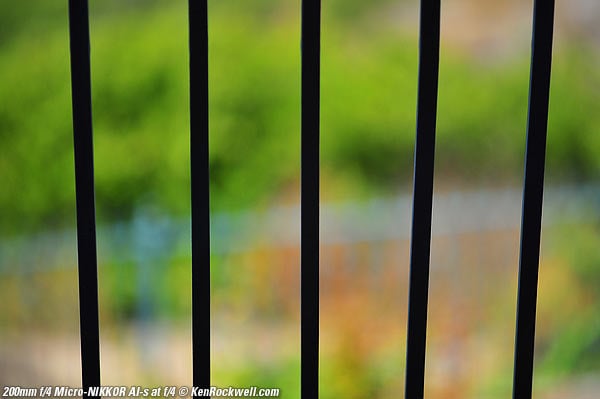
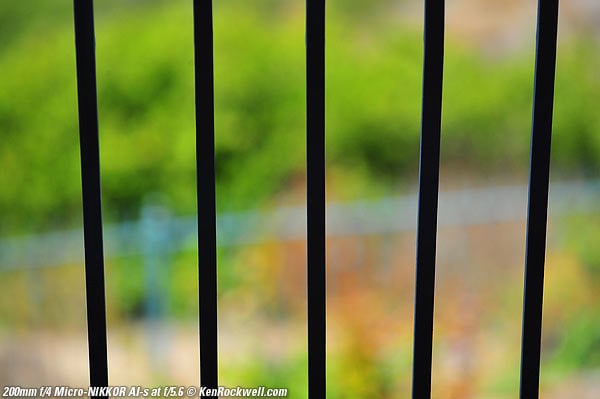
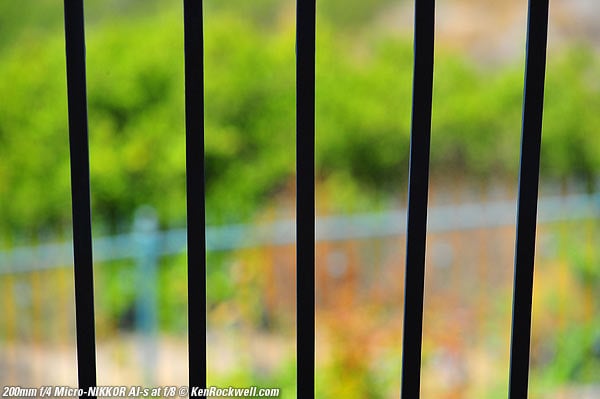
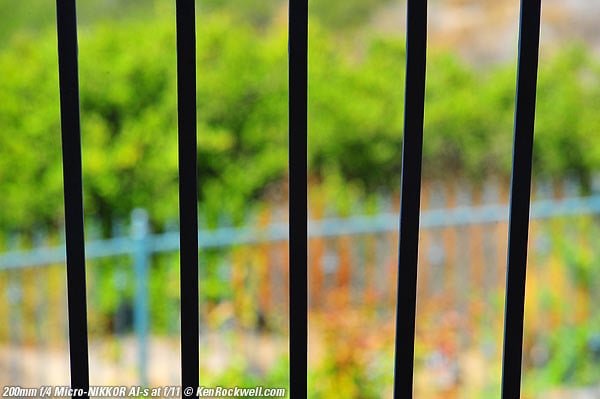
Color Rendition performance top
The color rendition seems the same as all my other modern NIKKORs.
Distortion performance top
The Nikon 200mm f/4 Micro-NIKKOR has minor pincushion distortion.
It can be corrected by plugging these figures into Photoshop CS2's lens distortion filter. These aren't facts or specifications, they are the results of my research that requires hours of photography and calculations on the resulting data.
FX and Film |
|
Infinity |
-0.5 |
15m (50 ft) |
-1.0 |
3m (10 ft) |
-0.5 |
1m (3 ft) |
-1.3 |
© 2010 KenRockwell.com. All rights reserved.
Ergonomics performance top
Nikon 200mm f/4 Micro-NIKKOR AI-s. enlarge.
The Nikon 200mm f/4 Micro-NIKKOR's ergonomics are perfect.
The tripod collar comes off for normal shooting.
If you use a pro camera like the D3S or F5, you'll probably need an AH-5 tripod adapter to attach your tripod to the collar itself in order for the battery compartment of your camera to clear your tripod. Don't worry if you can't score an AH-5; this lens is so light that you can bolt the camera directly to the tripod safely.
Falloff (darkened corners) performance top
In actual photography, falloff on FX is just about invisible at f/4, and gone by f/5.6.
It won't be an issue at all on DX (see crop factor).
I've exaggerated this by shooting a gray field and placing these on a gray background.
Nikon 200mm f/4 Micro-NIKKOR AI-s falloff on FX and film at infinity.
© 2010 KenRockwell.com. All rights reserved.
|
Filters, Use with performance top
There is no problem with vignetting, even with combinations of thick filters.
Lateral Color Fringes performance top
On a D3, there are visible lateral color fringes on the sides at macro distances.
At normal distances, there are none, and I doubt any of these would be visible at all on film.
This is too bad, since it makes this lens much less useful to me as a macro lens, since for my product shots, color fringes become obvious.
Here's a complete FX image:
LEICA SUMMARON 3.5cm f/3.5 (1958).
And here's the lower side enlarged:
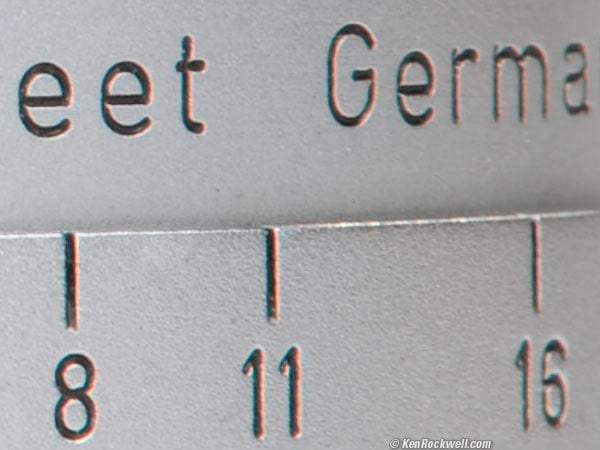
LEICA SUMMARON 3.5cm f/3.5 (1958).
Oddly, these go away at normal non-macro distances.
Mechanics performance top
Nikon 200mm f/4 Micro-NIKKOR AI-s. enlarge.
Like all Nikkor manual focus AI-s lenses, the Nikon NIKKOR 200mm f/4 Micro-NIKKOR AI-s is built to the highest mechanical standards of any lens ever made.
Barrel Exterior
Anodized and enameled aluminum.
Filter Threads
Anodized aluminum.
Hood
Threaded anodized aluminum, internal flocking.
Focus Ring
Metal, rubber covered.
Focus Helicoids
I'm unsure if this IF Micro-NIKKOR uses helicoids, or more likely, cams.
The focus is like melted butter: smooth and silky with no play or need for damping grease.
Depth-of-Field Scale
Engraved into barrel and filled with orange paint for f/32 (AI-s version).
Engraved into barrel and filled with green paint for f/32 (AI-s version).
Internals
All metal.
Aperture Ring
Cast aluminum, anodized and enameled.
Engraved markings filled with paint coded to the depth-of-field scale.
Mount
Dull-chromed brass.
Markings
Engraved into the metal and filled with paint.
Identity and Serial Number
On front of lens outside the filter ring.
Engraved into the metal and filled with paint.
Ass-Gasket (dust seal at mount)
No.
Noises When Shaken
Mild clicking from the diaphragm blades and actuation system.
Made in
Japan.
Sharpness performance top
Warning 1: Image sharpness depends more on you than your lens.
Warning 2: Lens sharpness doesn't mean much to good photographers.
With those caveats, the 200mm f/4 Micro-NIKKOR AI-s is quite sharp.
See examples for yourself at
Nikon 200mm Lens Center Sharpness Compared
and
Nikon 200mm Corner Sharpness Compared
It's sharp even wide-open at f/4. It gets only slightly sharper as stopped-down to f/8, and then diffraction limits performance more than the optics themselves at the smaller apertures.
Sunstars performance top
With its straight 9-bladed diaphragm, the 200mm f/4 Micro-NIKKOR should make magnificent 18-pointed sunstars on bright points of light.
Usage top
Intro Specs Performance Usage Compared Recommendations
The effective f/number becomes slower as one focusses more closely.
Here is a table of the expsure corrections to make, but only make them if you are unsing an external exposure meter. For most people using modern cameras with built-in meters, these are all calculated automatically.
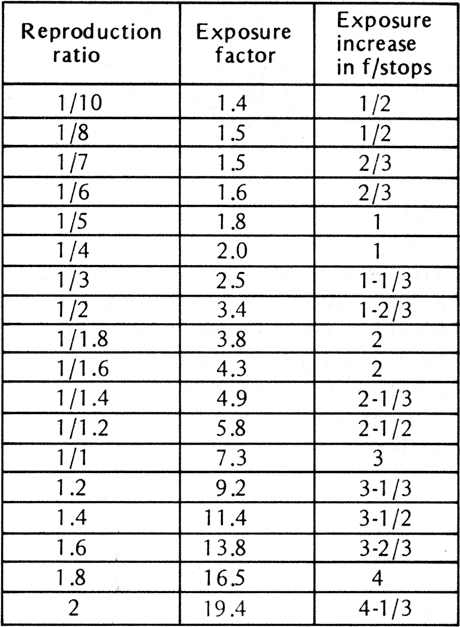
Nikon 200mm f/4 Micro Exposure Factors.
Compared top
Intro Specs Performance Usage Compared Recommendations
See also Best Macro Lenses Compared.
Sharpness
See sharpness comparisons for yourself at
Nikon 200mm Lens Center Sharpness Compared
and
Nikon 200mm Corner Sharpness Compared
Comparison Table
200/4 Micro AI-s |
|||
| Anni | 1978-2005 |
1993-today |
1975-1996 |
| Filter | 52mm |
62mm |
52mm |
| Optics | Very Good |
Spectacular |
Very Good |
| Diaphragm | 9 blades, f/32 |
9 blades, f/32 |
9 blades, f/32 |
Close Focus |
0.71m |
0.5m |
2m |
| Repro Ratio | 1:2 |
1:1 |
1:7.4 |
| Weight | 29.1 oz./824g |
41.6 oz./1,180g |
18.0 oz./510g |
| Price, 8/2010 | $100 used |
||
| Price, 4/2020 | $100 used |
Recommendations top
Intro Specs Performance Usage Compared Recommendations
This Nikon 200mm f/4 Micro-NIKKOR AI-s was Nikon's most exotic macro lens for decades. It was the dream of every insect photographer.
Today it sells for a song. Pay five times as much for the hulking AF-D version if you need to split pixels at the sides in the macro range, otherwise for your FX or film camera, this exotic is available used today for less than the price of my last CF card.
Deployment top
I'd leave either a 52mm Nikon Clear (NC - UV) filter, or a 52mm Hoya Super HMC UV on the lens at all times.
I'd pitch the flat Nikon cap that came with this lens and get a new 52mm "pinch" type cap, too. I'm not kidding: the new fatter caps are much easier to use in the field.
If I was working in nasty, dirty areas, I'd forget the cap, and use an uncoated 52mm Tiffen UV filter instead. Uncoated filters are much easier to clean, but more prone to ghosting.
Help me help you top
I support my growing family through this website, as crazy as it might seem.
The biggest help is when you use any of these links when you get anything, regardless of the country in which you live. It costs you nothing, and is this site's, and thus my family's, biggest source of support. These places have the best prices and service, which is why I've used them since before this website existed. I recommend them all personally.
If you find this page as helpful as a book you might have had to buy or a workshop you may have had to take, feel free to help me continue helping everyone.
If you've gotten your gear through one of my links or helped otherwise, you're family. It's great people like you who allow me to keep adding to this site full-time. Thanks!
If you haven't helped yet, please do, and consider helping me with a gift of $5.00.
As this page is copyrighted and formally registered, it is unlawful to make copies, especially in the form of printouts for personal use. If you wish to make a printout for personal use, you are granted one-time permission only if you PayPal me $5.00 per printout or part thereof. Thank you!
Thanks for reading!
Mr. & Mrs. Ken Rockwell, Ryan and Katie.
Home Donate New Search Gallery Reviews How-To Books Links Workshops About Contact

